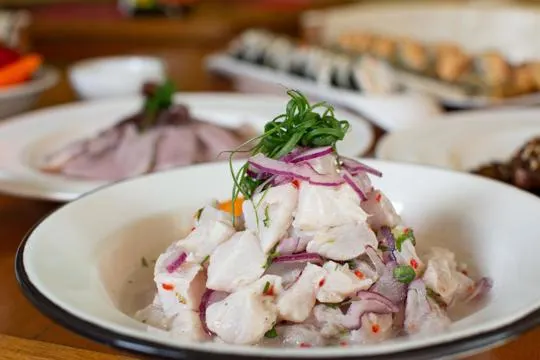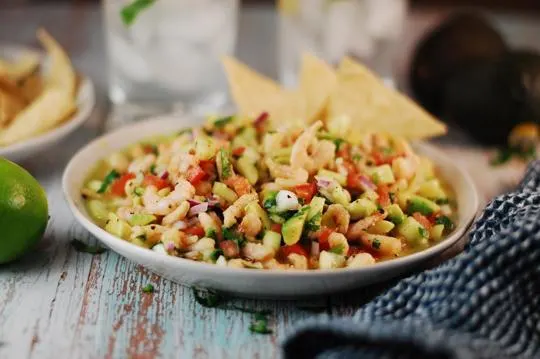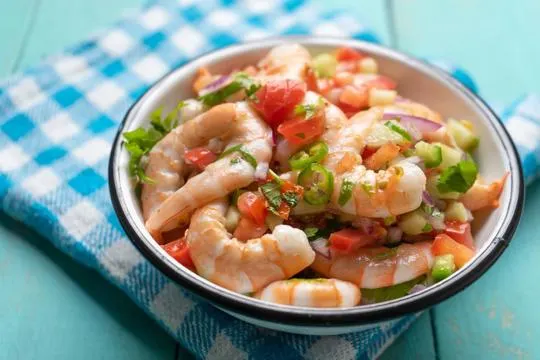Summary of key points
The main difference between Peruvian ceviche and Mexican ceviche is in the type of fish used. Peruvian ceviche traditionally uses sea bass, while Mexican ceviche often uses whitefish or shrimp.
Beyond the choice of fish, there are also differences in flavor and texture. Peruvian ceviche is typically marinated in lime juice for a shorter period of time, resulting in a slightly firmer texture and stronger citrus taste. Mexican ceviche is often marinated for longer, resulting in a more tender texture and milder flavor.
In terms of additional ingredients, Peruvian ceviche may include corn or sweet potatoes, while Mexican ceviche may include avocado or tomato.
In the universe of ceviche, two stars burn the brightest: Peru and Mexico. Both claim this dish, yet they serve it up in wildly different styles.
We’re here to slice through the fishy business and lay it all out. This isn’t just about chopped seafood; it’s a cultural showdown.
Ever tried Peruvian ceviche? It’s a citrus-soaked sensation, bold and brisk, with a hit of chili heat. On the flip side, Mexico tosses in its own twist – think avocado and a splash of tomato sauce for a smooth finish.
We’ve dipped our forks into both, laughing and debating over which plate takes the crown. Now, we’re dishing out the juicy details to you.
What is Peruvian Ceviche?

Peruvian Ceviche is renowned for its fresh, vibrant flavors.
It’s crafted by marinating raw fish in citrus juices like lime or lemon, which ‘cooks’ the fish.
Citrus acids break down the proteins, giving it a slightly firm and opaque texture.
Flavors are boosted with red onions, cilantro, garlic, and chili peppers.
Plus, heat and complexity.
The dish is usually served with sweet potato, corn kernels, and cancha (toasted corn).
One unique aspect is the addition of leche de tigre.
This marinade often includes ginger, celery, and pisco (Peruvian brandy).
It gives flavor and also serves as a dipping sauce for the finished ceviche.
What is Mexican Ceviche?

Mexican ceviche – a popular dish from Mexico – is renowned for its fresh, vibrant flavors.
It usually consists of marinated, raw fish or seafood, such as shrimp or snapper, and “cooked” in citrus juices – like lime or lemon juice.
The acidity from the citrus juice denatures the proteins in the fish, giving it a firm texture and a slightly “cooked” taste.
To enhance the flavor profile, Mexican ceviche often contains chopped onions, tomatoes, cilantro, jalapenos, and avocado.
This adds a depth of flavor and a refreshing crunch to the dish.
When it comes to presentation, Mexican ceviche is usually served in a bowl or on a plate, with tortilla chips or tostadas on the side.
The delicious combination of tangy ceviche and crispy chips creates an incredible contrast in textures.
Moreover, Mexican ceviche can be customized.
Additions like cucumber or mango add sweetness and crunchiness.
If you want some extra heat, just add spices, like chili powder or cayenne pepper.
Key Differences Between Peruvian Ceviche and Mexican Ceviche

Peruvian and Mexican ceviche may seem the same, but there are big differences.
Both use fresh seafood, but the ingredients and methods vary.
Ingredients and Flavor Profiles
Peruvian ceviche is renowned for its uncomplicated yet flavorful taste.
Its key ingredients are fresh raw fish or seafood, such as white fish or shrimp, and a tangy mix of lime juice and ají pepper.
Red onions and cilantro are then added for extra vibrancy.
In contrast, Mexican ceviche is more complex in terms of flavor.
Tomatoes bring sweetness and acidity, while onions add sharpness.
Herbs like cilantro and parsley provide freshness.
Jalapeños and serrano peppers add a spicy kick.
Though different, both versions of ceviche have their similarities.
Both are served cold, making them ideal for hot summer days.
They also both feature fresh seafood as their main ingredient.
Exploring the variations of ceviche gives us a glimpse into Latin American cuisine and its rich diversity.
Whether Peruvian or Mexican, this beloved dish is sure to please.
Preparation Techniques
Peruvian ceviche and Mexican ceviche are two popular dishes in the culinary world.
Both rely on fresh seafood, vibrant flavors, and skilled hands.
Peruvian ceviche is a delectable dish.
It showcases the country’s seafood heritage.
Fresh fish, such as sea bass or sole, is cut into small bite-sized pieces and marinated in citrus, usually lime or lemon.
Red onions and rocoto peppers add a spicy kick.
Cilantro and sweet potatoes or corn on top finish the presentation.
Mexican ceviche uses shrimp as the star ingredient.
It is cooked briefly, then marinated with lime or orange along with tomatoes, onions, cilantro, and jalapeños.
Avocado or mango can also be included.
Both types of ceviche don’t need heat-based cooking.
Peru serves it chilled with crunchy corn or yuca chips.
Mexico adds diced avocado or tortilla chips for creamy or crunchy texture.
Peruvian and Mexican ceviche have similarities.
But their flavor profiles and ingredients make each unique.
Appreciate the heritage and artistry behind these delightful dishes.
Regional Influences on Spices and Heat
Regional influences are important for the flavors of Peruvian and Mexican ceviche.
Spices and heat make them different. In Peru, they add ají amarillo.
This chili has a milder taste. Plus, they use lime juice to marinate for longer.
This creates a citrusy taste that goes with the seafood.
Mexican ceviche is spicier. They include jalapeño or serrano peppers for a fiery kick.
Tomato and cilantro make it colorful and aromatic.
Regional spices and heat show the diversity of these cuisines.
Serving Styles and Accompaniments
Peruvian ceviche and Mexican ceviche have different serving styles and accompaniments.
In Peru, ceviche is usually served as a main course in large portions.
It is often paired with sides like sweet potato, corn, and lettuce.
This dish is famous for its vibrant flavors and fresh seafood.
Whereas, Mexican ceviche is served as an appetizer or snack in small portions.
It is eaten with tortilla chips or tostadas.
Additionally, avocado, cucumber, and cilantro are added for texture and flavor.
These differences truly reflect the diverse culinary cultures of Peru and Mexico.
Similarities Between Peruvian Ceviche and Mexican Ceviche

Peruvian and Mexican ceviche have their own unique flavors.
Both dishes use fresh fish or seafood as the main ingredient.
Marinating in citrus juice, like lime or lemon, provides a tangy flavor.
Onions, chili peppers, and cilantro are added to enhance the taste and bring a hint of spice.
The marinating process is the same for both.
Seafood is not cooked with heat, but by the acid in citrus juice.
This gives it a tender texture, while preserving the natural flavors.
Fresh ingredients are used in both cuisines.
High-quality seafood and locally sourced vegetables make sure the taste is perfect.
Peruvian ceviche adds corn kernels, sweet potatoes, or yucca for complex flavors and textures.
Mexican ceviche usually includes tomatoes and avocado for a creamier texture.
Cultural Significance of Ceviche in Peru and Mexico
Ceviche is a traditional dish with deep roots in the culinary culture of Peru and Mexico.
It’s celebrated for its flavors and historical importance.
In Peru, it’s a national dish. It symbolizes the fusion of Inca cuisine with Spanish influences.
Peruvian ceviche usually includes fresh raw fish or seafood, marinated in citrus juices like lime or lemon.
Plus, onions, chili peppers, herbs, and seasonings.
The citrus cooks the fish, making it refreshing and flavorful.
Mexican ceviche has its own unique characteristics.
It has some similarities to Peruvian ceviche, like fresh seafood and citrus marinade.
But it also includes unique Mexican ingredients, like tomatoes, cucumbers, avocados, cilantro, mangoes, and pineapple.
Plus, serrano peppers for a kick.
The cultural significance of ceviche lies in more than just its preparation.
In Peru and Mexico, there are cevicherías, restaurants specializing in ceviche.
They’re important gathering spots for locals.
People come together to enjoy delicious food and have conversations, making lasting memories.
Ceviche also represents the strong bond between people in these countries and their reliance on ocean resources.
It’s made with freshly caught seafood.
It symbolizes their connection to coastal regions.
Exploring Variations in Other Latin American Cuisines
Latin America offers a delicious mix of flavors and dishes.
From Peru’s ceviche to Brazil’s feijoada and Argentina’s empanadas, the variety is astounding.
Colombia brings bandeja paisa, Chile hosts congrio fritters and curanto, Venezuela offers arepas.
Nicaragua dishes up gallo pinto, Guatemala has pepian, and Honduras is famous for baleadas.
Puerto Rico’s mofongo is hard to miss, and Cuba’s ropa vieja is not to be missed.
All these and more. Latin American cuisine is truly captivating.
Ready for a journey that will tantalize your taste buds? Dive into Latin American cuisine.
Conclusion
Peruvian ceviche versus Mexican ceviche has often been the subject of debate, and it seems that there is no real consensus on what makes them different.
While both cuisines produce delicious versions of the dish, each one has slight nuances that make it unique.
Enjoy trying each one and consider all of the ingredients and preparation processes to determine which style you prefer for yourself.
When trying this traditional dish from South America, don’t miss out on a chance to try the other style as well.
You may be surprised at how different they can taste.
With a little imagination, you can make either type into a truly special culinary experience.
To top it off, the freshness and nutrition made possible by utilizing fresh seafood will ensure your body is happy with your decision too.
Ultimately, nothing beats homemade ceviche any time of year – so why not pick up some seafood today?
Fact Checked:
Content is rigorously reviewed by a team of qualified and experienced fact checkers. Fact checkers review articles for factual accuracy, relevance, and timeliness.

Leave a comment